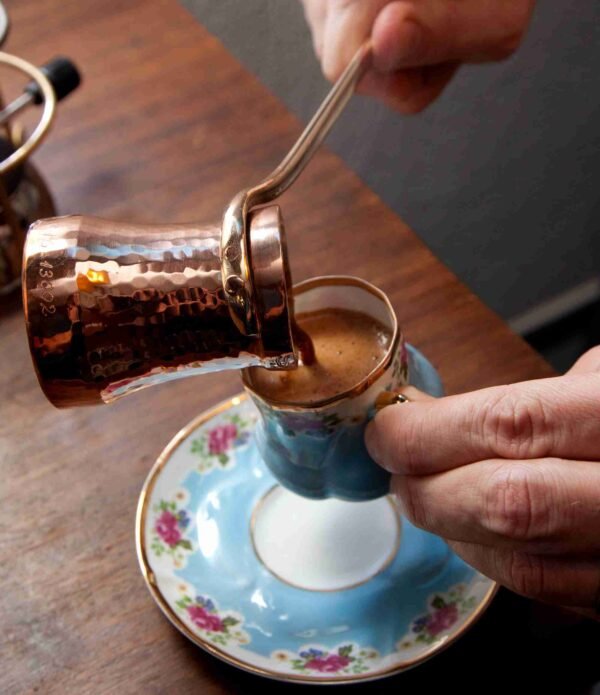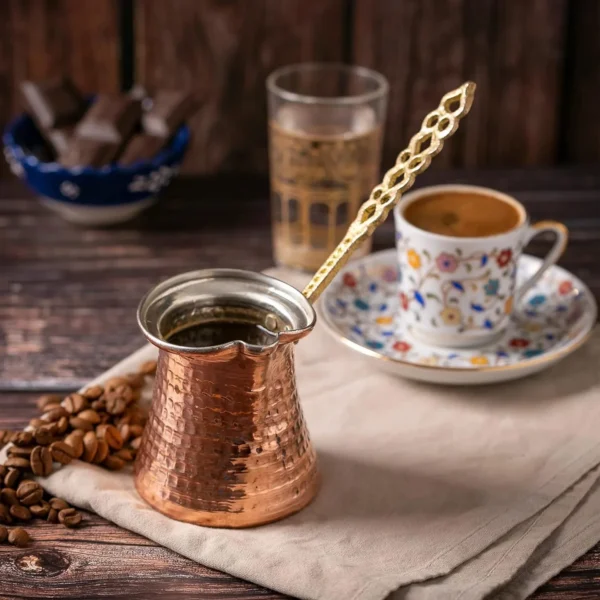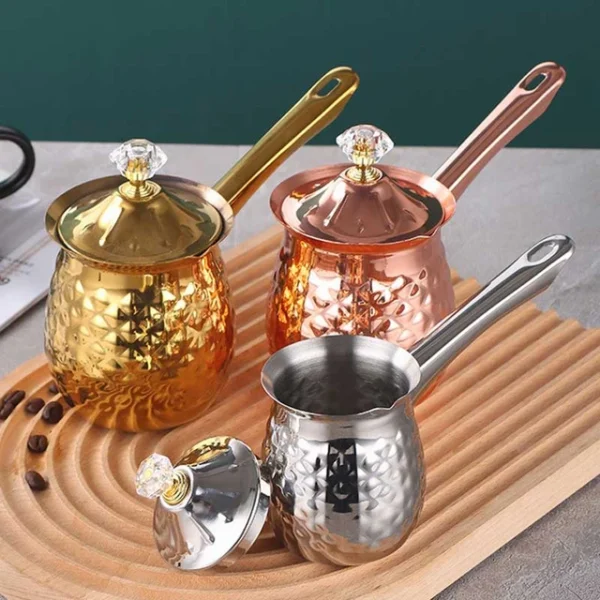
When exploring the global scene of Turkish coffee the words of The Coffee Guru resonate deeply, “For a true Turkish coffee experience, use a cezve when boiling your cup of joe.” This comprehensive guide is crafted to assist you in finding the ideal cezve, a crucial step in embracing this rich cultural tradition.
The cezve is not just a tool; it’s a gateway to a centuries-old practice, deeply ingrained in Turkish heritage. This guide is designed to enlighten you on choosing the perfect cezve, considering factors like material, size, and design, all pivotal for achieving that exquisite cup of coffee.

Whether you are an experienced coffee enthusiast or just beginning your journey, understanding the intricacies of the cezve is key to enhancing your Turkish coffee experience, connecting you to a longstanding ritual cherished by coffee lovers worldwide.
Understanding Turkish Coffee
Turkish coffee transcends being merely a beverage; it holds a revered status as a cultural emblem deeply woven into the fabric of daily life in Turkey and numerous neighbouring regions. Its significance extends far beyond its role as a drink, as it symbolizes tradition, hospitality, and connection.
History and Significance
With its roots in the Ottoman Empire, Turkish coffee holds a legacy of fostering social bonds.
Origins: The history of Turkish coffee dates back to the Ottoman Empire, where it became a significant part of the culture in the 16th century. It was a symbol of hospitality and social interaction, often served during gatherings and meetings.
Cultural Impact: Over the centuries, Turkish coffee has transcended its role as just a drink. It became a pivotal part of various ceremonies, including weddings and diplomatic meetings. Its cultural importance is so profound that UNESCO recognized it as an Intangible Cultural Heritage of Humanity.
Traditional Preparation
Preparing Turkish coffee involves a unique method and presentation.
Unique Brewing Method: Preparing Turkish coffee involves a unique method. Finely ground coffee beans are simmered (not boiled) with water and often sugar, in a special pot called a ‘cezve’ or ‘ibrik’.
Serving Style: The coffee is served in small cups, similar to espresso cups. What makes it distinctive is that the coffee grounds are not filtered out, settling at the bottom of the cup.
Taste and Aroma

This delectable beverage is known for its intense flavour and enticing aroma.
Rich and Intense Flavor: The taste of Turkish coffee is much more potent and richer than regular coffee due to its fine grounds and the method of preparation.
Aromatic Experience: The brewing process releases a strong and enticing aroma, characteristic of Turkish coffee. The addition of spices like cardamom can further enhance its flavour profile.
Aftertaste: One unique aspect is its aftertaste. The fine coffee grounds that settle at the bottom of the cup provide a lingering taste long after the coffee is consumed.
In summary, Turkish coffee is not just a drink but a cultural artifact, steeped in history and tradition. It’s unique preparation and rich flavour profile make it a distinctive and cherished beverage across the world.
Types of Cezve
The Cezve, a traditional pot used for brewing Turkish coffee, is a key component in its preparation. Its design and material significantly influence the brewing process and the coffee’s overall flavour. There are various types of Cezves, each offering unique benefits and characteristics.
Copper Cezve
Copper Cezves are favoured for their distinct advantages, contributing to the unique charm of Turkish coffee preparation.
- Heat Conductivity: Copper Cezves are highly valued for their superior heat conductivity. This feature allows for quick and even heating, essential for perfectly brewed Turkish coffee.
- Traditional Appeal: Often handmade and adorned with intricate designs, copper Cezves have a traditional appeal. They are not just tools for brewing but also artistic pieces that represent cultural heritage.
- Maintenance: Copper requires regular polishing and maintenance to prevent tarnishing and maintain its excellent heat-conductive properties.
Brass Cezve
Brass Cezves are known for their unique features that enhance the brewing experience.
- Durability: Brass Cezves stand out for their durability. The alloy of copper and zinc makes them more robust and less prone to damage compared to pure copper.
- Heat Retention: While brass doesn’t conduct heat as quickly as copper, it excels in retaining heat, providing a steady brewing temperature.
- Aesthetic and Care: Brass Cezves often have a golden hue, adding an aesthetic value. They require less maintenance than copper but may need occasional polishing to keep their shine.
Stainless Steel Cezve
Stainless Steel Cezves offer practical benefits that make them a convenient choice for coffee enthusiasts.
- Modern and Practical: Stainless steel Cezves are a more modern option. They are known for their practicality and ease of maintenance.
- Corrosion Resistance: Unlike copper and brass, stainless steel is highly resistant to corrosion and tarnishing, making it a low-maintenance option.
- Heat Distribution: While not as efficient in heat conductivity as copper, stainless steel Cezves offer decent heat distribution, suitable for a consistent brew.
In summary, each type of Cezve brings its unique set of characteristics to the coffee brewing process. Whether it’s the quick and even heating of a copper Cezve, the durability and heat retention of a brass one, or the practicality and modern appeal of stainless steel, choosing the right Cezve can enhance the experience of making and enjoying Turkish coffee.
Turkish Coffee Pot: Size and Capacity

The Turkish coffee pot, known as a cezve or ibrik, is a fundamental tool in the traditional brewing of Turkish coffee. Its size and capacity are critical factors that influence not only the quantity of coffee produced but also the quality and taste. From single-serving pots to those designed for family use, each has its unique role in the art of coffee making.
Single-Serving vs. Family-Size
Different pot sizes cater to individual or group coffee needs.
- Single-Serving Pots: These pots are designed to brew one cup of coffee at a time. They allow for precise control over the coffee’s strength and flavor, catering to individual preferences. The small size facilitates quick heating and is ideal for personal use or when serving different types of coffee to guests.
- Family-Size Pots: Larger pots are used to prepare multiple servings of coffee simultaneously. They are efficient when serving a group or family, ensuring uniformity in taste and strength across cups. However, they require a bit more skill to manage the brewing process evenly.
Capacity and Brewing Time
Pot size affects brewing time, necessitating appropriate capacity selection.
- Influence on Brewing Time: The size of the pot directly impacts the brewing time. Smaller pots heat up faster, reducing the brewing time, whereas larger pots require more time for the water to reach the ideal brewing temperature.
- Optimal Capacity: Choosing the right capacity is crucial. A pot that’s too large for a small amount of coffee can result in under-extraction, while an overly small pot can lead to spillage during brewing.
Aesthetics and Tradition
Turkish coffee pots hold cultural significance and often feature decorative designs.
- Cultural Significance: In Turkish culture, the coffee pot is not just a brewing vessel; it’s a symbol of hospitality and tradition. Its design and size reflect the cultural importance of coffee in social settings.
- Decorative Aspects: Turkish coffee pots often feature ornate designs, especially the traditional brass or copper ones. These aesthetic considerations make them not just functional tools but also decorative pieces in a kitchen.
Summing up, the size and capacity of a Turkish coffee pot play a pivotal role in the brewing process, affecting everything from brewing time to the flavour of the coffee. While single-serving pots offer precision and individuality, family-size pots are more suited for communal settings. Beyond their practical utility, these pots are imbued with cultural significance and aesthetic value, making them cherished components in the tradition of Turkish coffee preparation.
The Art of Brewing Turkish Coffee
Brewing Turkish coffee is considered an art form, combining precise measurements, meticulous heat control, and a specific frothing technique. Each step in the process is crucial to creating the perfect cup of this richly flavoured and culturally significant beverage.
Measuring Ingredients
The initial steps in making Turkish coffee involve precise ingredient measurements.
- Precision is Key: The first step in brewing Turkish coffee is precise measurement of the ingredients. Typically, one heaped teaspoon of finely ground coffee is used per cup, along with a corresponding amount of water, and sugar to taste.
- Water-to-Coffee Ratio: The ratio of water to coffee is critical. Too much water will dilute the coffee, while too little will make it overly strong and potentially bitter.
- Finding the Right Balance: The ratio of coffee grinds to water is also critical in all coffee brewing methods. When creating a classic cup of Turkish coffee, start with a single part coffee and ten parts water, but feel free to experiment and adjust the ratio to your preference.
Roast and Grind Selection
Selecting the appropriate roast level for your coffee beans and matching the grind size to your brewing method are key factors in enhancing flavour.
- Choosing the Right Roast: The roast of the coffee beans greatly affects the flavour. Light roasts tend to be more acidic and retain more of the bean’s original flavour, while dark roasts are smoother and have a more robust flavour profile.
- Grind Size Matters: The size of the coffee grind should match your brewing method. Extra-fine grinds are ideal for Turkish coffee.
- Freshness Factor: Freshly ground coffee beans make a significant difference. Grinding beans right before brewing preserves the coffee’s aroma and flavour.
Maintenance and Care
Proper maintenance and care of coffee tools, especially the traditional Cezve, are essential for preserving their functionality and ensuring the quality of the coffee brewed. This involves careful cleaning, appropriate storage, and avoiding common pitfalls that can lead to wear or damage.
Cleaning and Seasoning
Taking care of your coffee equipment is important. Clean your Cezve appropriately based on its material and consider occasional seasoning for certain types.
- Cleaning the Cezve: After brewing, it’s important to clean the Cezve thoroughly to remove coffee residue. For materials like copper or brass, gentle cleaning with a soft sponge and mild soap is recommended, followed by drying to prevent tarnishing.
- Seasoning Copper or Brass Cezves: If you have a copper or brass Cezve, occasional seasoning helps maintain its surface. This can be done by gently heating the pot and applying a thin layer of oil, then letting it cool.
- Non-abrasive Cleaning for Stainless Steel: For stainless steel Cezves, avoid abrasive cleaners that can scratch the surface. Instead, use warm water and a gentle detergent, and ensure it’s completely dry after washing to prevent water spots.
Storage Tips
Properly storing your coffee tools in a dry, cool environment and avoiding clutter or potential damage will help prolong their lifespan.
- Dry and Cool Storage: Store the Cezve and other coffee tools in a dry, cool place to prevent moisture buildup, which can cause rust or tarnish, especially on metal surfaces.
- Prevent Clutter and Damage: Avoid storing your Cezve in a cluttered drawer where it can get dented or scratched. Hanging or placing it on a stable shelf can prevent accidental damage.
- Storing Coffee Accessories: For other coffee tools like grinders, tampers, or spoons, organize them in a way that prevents damage and keeps them easily accessible for use.
